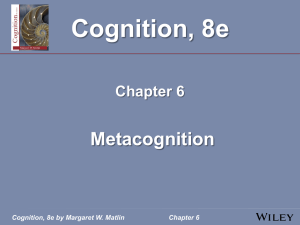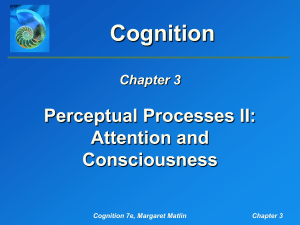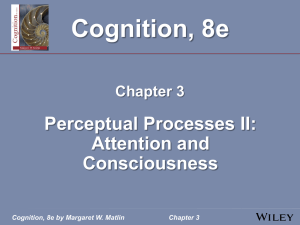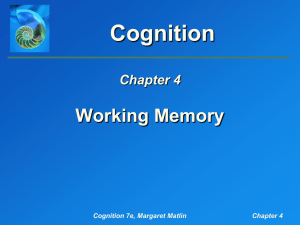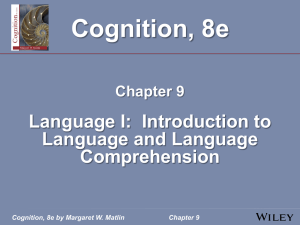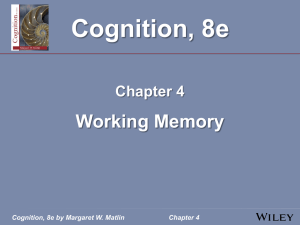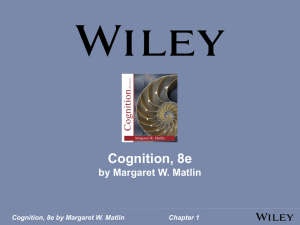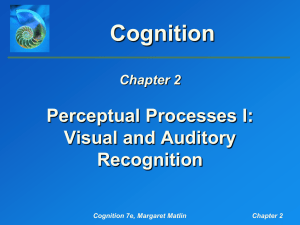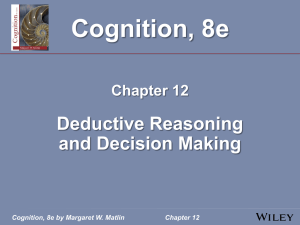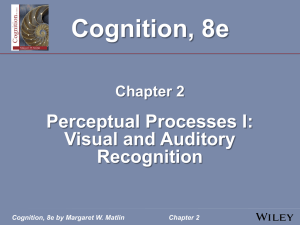Cognition 7e, Margaret Matlin Chapter 13 Cognition Cognitive
advertisement
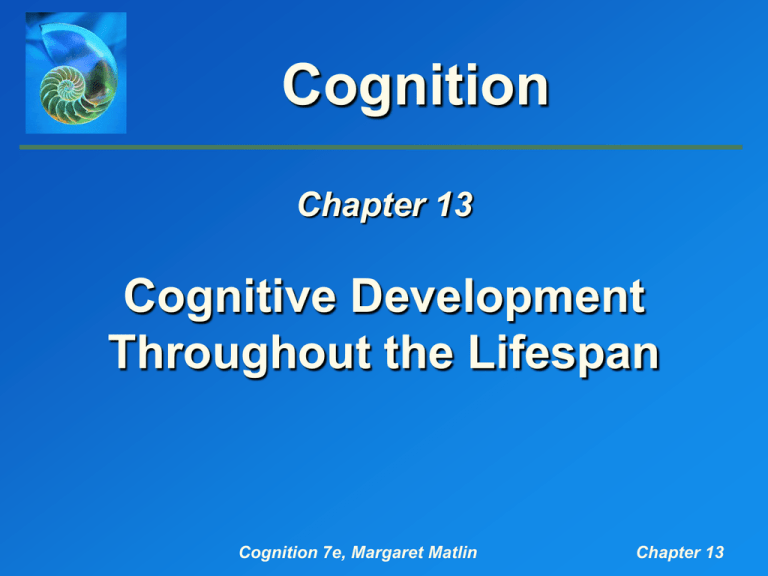
Cognition Chapter 13 Cognitive Development Throughout the Lifespan Cognition 7e, Margaret Matlin Chapter 13 Introduction lifespan approach to development Cognition 7e, Margaret Matlin Chapter 13 The Lifespan Development of Memory Memory in Infants early research underestimated infants' memory abilities Attention Patterns Methodology - looking time own-race bias Cognition 7e, Margaret Matlin Chapter 13 The Lifespan Development of Memory Memory in Infants Attention Patterns Sangrigoli and de Schonen • • • photos of White and Asian women's faces shown to White babies present one photo (either White or Asian woman) repeatedly until looking time decreases present pair of photos—familiar/unfamiliar White women or familiar/unfamiliar Asian women Cognition 7e, Margaret Matlin Chapter 13 The Lifespan Development of Memory Memory in Infants Attention Patterns Sangrigoli and de Schonen • • • looking time for unfamiliar White woman longer than familiar White woman no difference for familiar/unfamiliar Asian women Further questions? Cognition 7e, Margaret Matlin Chapter 13 The Lifespan Development of Memory Memory in Infants Recognizing Mother visual recognition – post-natal mother's voice - prenatal Cognition 7e, Margaret Matlin Chapter 13 The Lifespan Development of Memory Memory in Infants Conjugate Reinforcement Carolyn Rovee-Collier and colleagues nonverbal measures of memory conjugate reinforcement technique—mobile, ribbon, kicking • baseline, spontaneous kicking • acquisition phase • number of kicks produced following delay Cognition 7e, Margaret Matlin Chapter 13 Conjugate Reinforcement Technique Cognition 7e, Margaret Matlin Chapter 13 Memory in Infants Cognition 7e, Margaret Matlin Chapter 13 The Lifespan Development of Memory Memory in Infants Conjugate Reinforcement Carolyn Rovee-Collier and colleagues (continued) older infants—press lever to run train steady linear improvement during first 18 months of life context effects interference spacing effect levels of processing Cognition 7e, Margaret Matlin Chapter 13 The Lifespan Development of Memory Memory in Children Children's Working Memory memory span 2y - 2, 9y - 6 three working memory components relationship to school performance Cognition 7e, Margaret Matlin Chapter 13 The Lifespan Development of Memory Memory in Children Children's Long-Term Memory Good by 20 months 2 year-olds can recall events a few months old excellent recognition but poor recall Recall improves after about 9y Myers and Perlmutter (1978) object recognition and recall Cognition 7e, Margaret Matlin Chapter 13 The Lifespan Development of Memory Memory in Children Children's Long-Term Memory 1. Autobiographical memory and early childhood childhood amnesia infant memory deferred imitation lack of well-organized sense of who they are difficulty encoding and retrieving reminders Cognition 7e, Margaret Matlin Chapter 13 The Lifespan Development of Memory Memory in Children Children's Long-Term Memory 2. Children's source monitoring source monitoring Foley, Ratner and colleagues • performing vs. imagining how it would feel vs. visualizing • performing vs. watching another person perform a task Cognition 7e, Margaret Matlin Chapter 13 The Lifespan Development of Memory Memory in Children Children's Memory Strategies memory strategies utilization deficiency 1. Rehearsal not very effective, but can keep information in working memory 4- and 5-year-olds do not spontaneously use rehearsal can benefit from rehearsal if prompted Cognition 7e, Margaret Matlin Chapter 13 The Lifespan Development of Memory Memory in Children Children's Memory Strategies 2. Organizational strategies categorizing and grouping Moely and colleagues—children study pictures from four categories; younger children rarely rearrange into categories 3. Imagery even 6-year-olds can be trained to use visual imagery effectively Cognition 7e, Margaret Matlin Chapter 13 The Lifespan Development of Memory Memory in Children Children's Eyewitness Testimony Leichtman and Ceci—"Sam Stone" study • • • • control, stereotype, suggestion, and stereotype-plussuggestion groups children interviewed about Sam Stone 10 weeks after visit control group highly accurate children can provide valid eyewitness testimony if they do not receive misleading information, either before or after the target event Cognition 7e, Margaret Matlin Chapter 13 Children's Eyewitness Testimony Cognition 7e, Margaret Matlin Chapter 13 The Lifespan Development of Memory Memory in Children Children's Eyewitness Testimony age, stereotyping, and misleading suggestions all influence children's eyewitness testimony social factors reluctance to say "I don't know" change statements under cross-examination Cognition 7e, Margaret Matlin Chapter 13 The Lifespan Development of Memory Individual Differences: Children’s Intelligence and Eyewitness Testimony Henry and Gudjonsson (2007) children with mental retardation vs. typically developing children older and younger children misleading questions Cognition 7e, Margaret Matlin Chapter 13 Individual Differences: Children’s Intelligence and Eyewitness Testimony Cognition 7e, Margaret Matlin Chapter 13 The Lifespan Development of Memory In Depth: Memory in Elderly People stereotypes large individual differences complex developmental trends Working Memory in Elderly People nature of the task Stine and coauthors (1989)—recall for spoken English • • normal syntax/normal rate vs. random order/fast rate significant age difference for complicated, non-real-life task Cognition 7e, Margaret Matlin Chapter 13 The Lifespan Development of Memory In Depth: Memory in Elderly People Long-Term Memory in Elderly People perform well on semantic memory tasks and easy, automatic tasks age differences on more complex tasks Cognition 7e, Margaret Matlin Chapter 13 The Lifespan Development of Memory In Depth: Memory in Elderly People Long-Term Memory in Elderly People 1. Prospective memory simulated shopping task complete fewer tasks and make more errors perform more accurately when they have an environmental cue can even perform better than younger adults Cognition 7e, Margaret Matlin Chapter 13 The Lifespan Development of Memory In Depth: Memory in Elderly People Long-Term Memory in Elderly People 2. Implicit memory Light and colleagues (1995) reading familiar letter sequence older and younger adults performed similarly 3. Explicit recognition memory long-term recognition memory declines slowly or not at all Cognition 7e, Margaret Matlin Chapter 13 The Lifespan Development of Memory In Depth: Memory in Elderly People Long-Term Memory in Elderly People 4. Explicit recall memory performance decreases slowly and age differences are more substantial Dunlosky and Hertzog (1998)—pairs of unrelated words names, historical details, stories large individual differences—verbal ability, education Hasher and colleagues—time of day Cognition 7e, Margaret Matlin Chapter 13 The Lifespan Development of Memory In Depth: Memory in Elderly People Explanations for Age Differences in Memory changes in brain structures 1. Difficulty paying attention 2. Ineffective use of memory strategies 3. The contextual-cues hypothesis 4. Cognitive slowing Cognition 7e, Margaret Matlin Chapter 13 The Lifespan Development of Metamemory metacognition metamemory metacomprehension Cognition 7e, Margaret Matlin Chapter 13 The Lifespan Development of Metamemory Metamemory in Children Flavell theory of mind—people's ideas on how their minds work and on their beliefs about other people's thoughts Cognition 7e, Margaret Matlin Chapter 13 The Lifespan Development of Metamemory Metamemory in Children Children's Understanding of How Memory Works small vs. large memory sets related vs. random words effectiveness of memory strategies Cognition 7e, Margaret Matlin Chapter 13 The Lifespan Development of Metamemory Metamemory in Children Children's Awareness That Effort Is Necessary young children do not appreciate the need for effort keep studying information they already know not accurate in judging what has been committed to memory don't realize that they need to make an effort to use a memory strategy naive ideas about the effort required for memorization Cognition 7e, Margaret Matlin Chapter 13 The Lifespan Development of Metamemory Metamemory in Children Children's Judgments About Their Memory Performance younger children unrealistically optimistic Roebers and colleagues memory for magic show confidence ratings overconfidence Cognition 7e, Margaret Matlin Chapter 13 Metamemory in Children Figure 13.5 Average Level of Confidence for Questions Answered Correctly and Questions Answered Incorrectly. (1 = Very Unsure; 5=Very Sure) Cognition 7e, Margaret Matlin Chapter 13 The Lifespan Development of Metamemory Metamemory in Children Children's Metamemory: The Relationship Between Metamemory and Memory Performance—Summary 1. Their metamemory is faulty; they do not realize that they need to make an effort to memorize, and they also do not realize how little they can remember. 2. They do not spontaneously use helpful memory strategies. 3. Relative to older children, their memory performance is poor. Cognition 7e, Margaret Matlin Chapter 13 The Lifespan Development of Metamemory Metamemory in Children Children's Metamemory: The Relationship Between Metamemory and Memory Performance—Summary Is there a causal link? Metamemory Strategy use Memory performance Cognition 7e, Margaret Matlin Chapter 13 The Lifespan Development of Metamemory Metamemory in Children Children's Metamemory: The Relationship Between Metamemory and Memory Performance—Summary • • • some evidence that metamemory is related to strategy use extensive evidence that strategy use is related to memory performance moderate correlation between metamemory and memory performance Cognition 7e, Margaret Matlin Chapter 13 The Lifespan Development of Metamemory Metamemory in Elderly People 1. Beliefs about memory younger and older adults share similar beliefs 2. Memory monitoring equally skilled on some tasks—predicting items they will recall, selecting most difficult items for further study, judging accuracy on general-knowledge questions, deciding whether an item is old or new overconfident on some tasks—overall performance on a test of memory for specific details about a recent event Cognition 7e, Margaret Matlin Chapter 13 The Lifespan Development of Metamemory Metamemory in Elderly People 3. Awareness of memory problems problems with everyday memory some elderly people don't try to develop helpful memory strategies because they think that memory decline is inevitable memory self-efficacy—the belief in one's own potential to perform well on memory tasks Cognition 7e, Margaret Matlin Chapter 13 The Development of Language Language in Infants rate of acquisition vocabulary size creative language use Cognition 7e, Margaret Matlin Chapter 13 The Development of Language Language in Infants Speech Perception in Infancy phonemes speech-sound categories across speakers Eimas and coauthors habituation studies, sucking response dishabituation indicates perceiving difference between sounds Cognition 7e, Margaret Matlin Chapter 13 The Development of Language Language in Infants Speech Perception in Infancy Werker and Tees—distinguishing sounds in other languages Kuhl—relearning lost distinctions language rhythms bilingual homes and language discrimination Cognition 7e, Margaret Matlin Chapter 13 The Development of Language Language in Infants Language Comprehension in Infancy 1. Recognizing important words name, mommy, daddy 2. Discriminating between grammatical words and meaning words Cognition 7e, Margaret Matlin Chapter 13 The Development of Language Language in Infants Language Comprehension in Infancy 3. Understanding the correspondence between sound and sight emotional tone of spoken language Walker-Andrews recordings of either a happy voice or an angry voice side-by-side films of happy speaker and angry speaker infants watched the face that matched the emotion of the voice Cognition 7e, Margaret Matlin Chapter 13 The Development of Language Language in Infants Language Comprehension in Infancy 4. Appreciating semantic concepts Mandler and colleagues—concepts about objects distinguishing between visually similar objects animate/inanimate objects "animal" vs. "vehicle" categories concepts become more refined Cognition 7e, Margaret Matlin Chapter 13 The Development of Language Language in Infants Language Production in Infancy cooing babbling intentional communication Cognition 7e, Margaret Matlin Chapter 13 The Development of Language Language in Infants Adults' Language to Infants child-directed speech motherese fathers adults typically use a different language style when speaking to infants and young children than when speaking to older people differences across language communities mothers who are depressed Cognition 7e, Margaret Matlin Chapter 13 The Development of Language Language in Children Words early words and concepts word production comprehension of words interrelationship of memory and language Cognition 7e, Margaret Matlin Chapter 13 The Development of Language Language in Children Words fast mapping—using context to make a reasonable guess about a word's meaning Heibeck and Markman (1987) series of paired objects familiar and unfamiliar terms overextension underextension Cognition 7e, Margaret Matlin Chapter 13 The Development of Language Language in Children Morphology morphemes morphology pay greater attention to phrases with appropriate morphology create their own regular forms Cognition 7e, Margaret Matlin Chapter 13 The Development of Language Language in Children Morphology overregularization—the tendency to add the most customary morphemes to create new forms of irregular words parallel distributed processing explanation—language system keeps tally of morpheme patterns; patterns of excitation within neural networks account for overregularization rule-and-memory theory (Marcus)—children learn a general rule for past-tense verbs and also store in memory the past tenses for many irregular verbs Cognition 7e, Margaret Matlin Chapter 13 The Development of Language Language in Children Syntax combining words into sentences two-word utterances morphology and syntax active process using syntax cues Cognition 7e, Margaret Matlin Chapter 13 The Development of Language Language in Children Pragmatics learning the social rules of language what to say, to whom, language styles, coordinating conversations Cognition 7e, Margaret Matlin Chapter 13 The Development of Language Language in Children Pragmatics adapting language to the listener Shatz and Gelman (1973) 4-year-olds speaking to 2-year-olds, 4-year-olds and adults 2-year olds speaking to infants taking turns in conversation gestures of interest; listener responses Cognition 7e, Margaret Matlin Chapter 13
